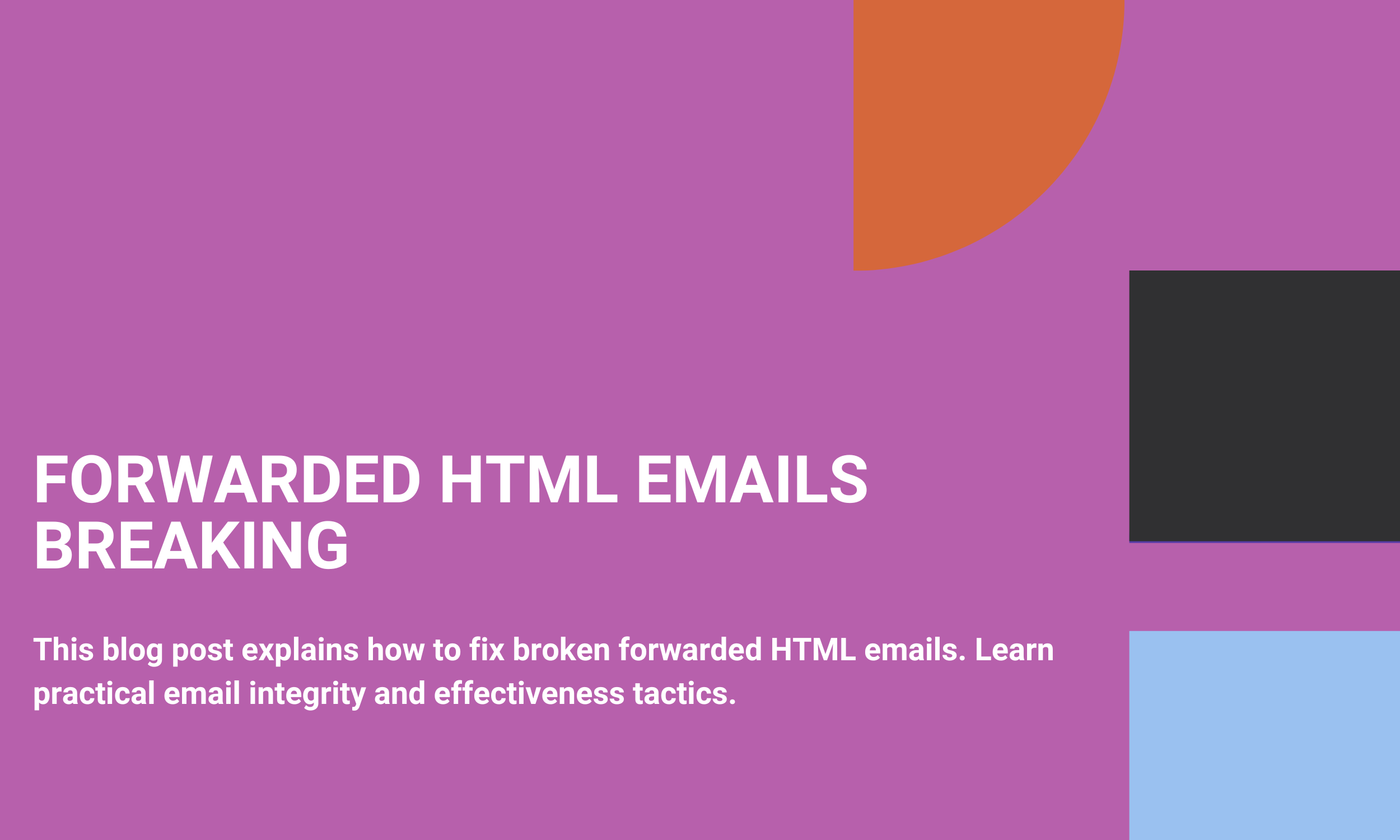Services List
Email marketing remains a cornerstone in the digital strategy of many businesses, allowing for direct communication with customers. However, the process of forwarding HTML emails can sometimes disrupt the intended presentation, leading to a host of formatting issues. This article delves into the reasons behind these disruptions and provides practical strategies for managing and minimising their impact.

Covered in this article
Why Forwarded Emails Break
4 Strategies for Managing Broken Forwards
Control What You Can (and Let the Rest Go)
FAQs About HTML Emails Breaking
Why Forwarded Emails Break
The main challenge with HTML email forwarding lies in the inconsistency of email client behaviour. Each email client has its way of interpreting and displaying HTML content, which can lead to significant alterations when an email is forwarded. Common issues include:
- HTML Code Alteration: Email clients may remove or change parts of the HTML code during the forwarding process, affecting the email's layout and design.
- Rendering Differences: Variability in how email clients render emails can lead to changes in appearance, including altered text formatting and image display.
- Client Settings and Preferences: Users' settings and preferences can also affect how forwarded emails are displayed, further complicating the issue.
- Image Blocking and Resizing: Some email clients may block or resize images in forwarded emails, which can disrupt the visual balance of the email.
These issues can frustrate both senders and recipients, detracting from the user experience and potentially diminishing the effectiveness of your email campaigns.
4 Strategies for Managing Broken Forwards
1. Simplify Your HTML Email Formatting
The first line of defence against forwarding issues is to simplify your email design. Consider these guidelines:
- Use Single-Column Layouts: A single-column layout, designed with one HTML table, is less susceptible to forwarding issues.
- Text-Based Information: Ensure key messages and calls to action are conveyed in text to reach recipients where images have been blocked.
- Limit Special Content: Use animations and background images sparingly, as they are more prone to breaking upon forwarding.
2. Include a "View in Browser" Link
Adding a "view in browser" link provides a failsafe by allowing recipients to view the email in their web browser, bypassing email client inconsistencies. This enhances accessibility and ensures that your email's content displays correctly for all recipients.
3. Avoid Forwarding Test Emails
Forwarding test emails within your team can lead to premature formatting issues. Instead, utilise the 'send test' feature in your Email Service Provider (ESP) to ensure that test emails are viewed as intended, without the alterations caused by the forwarding process.
4. Incorporate Sharing CTAs
Since forwarding is sometimes desirable, incorporating sharing Calls to Action (CTAs) can help maintain your email's integrity. Options include:
- Forward-to-a-Friend CTA: Allows for easy sharing while enabling you to capture the recipient's information for personalised follow-up emails.
- Share with Your Network CTA: Facilitates sharing through social media or direct links, keeping the formatting consistent.
Control What You Can (and Let the Rest Go)
While it's important to take steps to ensure your HTML emails maintain their integrity, some aspects of the forwarding process are beyond your control. Embrace the fact that forwarded emails signify engagement and interest. By focusing on simplified designs and providing easy viewing and sharing options, you can mitigate the risks associated with broken forwards and maintain the consistency of your message as it travels from inbox to inbox.
In summary, while forwarded email breaking can pose challenges, understanding the underlying causes and implementing these strategic solutions can help maintain the effectiveness and appearance of your email communications, ultimately enhancing your email marketing efforts.
Need assistance with your emails that keep breaking? Then chat with one of our marketing specialists and we will ensure that your emails are optimised for any and all platforms.
FAQs About HTML Emails Breaking
Why do forwarded emails often break or look different?
Forwarded emails can break due to the varied ways email clients handle HTML content. When an email is forwarded, the forwarding email client might alter the HTML code, change the rendering, or apply different settings and preferences, leading to issues like altered text formatting, resized or blocked images, and disrupted layout.
How can I prevent my HTML emails from breaking when forwarded?
Completely preventing HTML emails from breaking when forwarded is challenging due to the diverse handling by different email clients. However, simplifying your email design, using single-column layouts, minimising the use of special content like animations, and ensuring key information is in text form can help reduce the risk.
What is the purpose of a "View in Browser" link in emails?
A "View in Browser" link provides an alternative way for recipients to view the email content directly in their web browser. This bypasses the email client's rendering engine, potentially avoiding the issues that can arise when emails are forwarded, and ensuring the email is accessible and displays correctly for everyone.
Is it a bad practice to forward test emails for review?
Forwarding test emails can lead to formatting issues, giving a false impression of how the email appears. It's better to use the 'send test' feature provided by most Email Service Providers (ESPs), which ensures that the email is delivered directly and viewed in its intended format.
Can I control how my email looks when it is forwarded?
While you can't control how all email clients will render your email upon forwarding, you can mitigate the impact by simplifying your email's design and layout, using web-safe fonts, and including a "View in Browser" link. These steps can help maintain the integrity of your email's appearance to some extent.
Why should I include sharing CTAs in my emails?
Sharing CTAs like "Forward to a Friend" or social media sharing links encourages recipients to share your content in a more controlled manner, potentially reducing the risk of formatting issues associated with forwarding. These CTAs also allow you to track shares and engagements more effectively.




